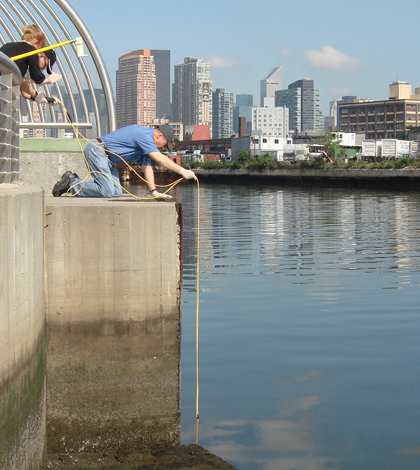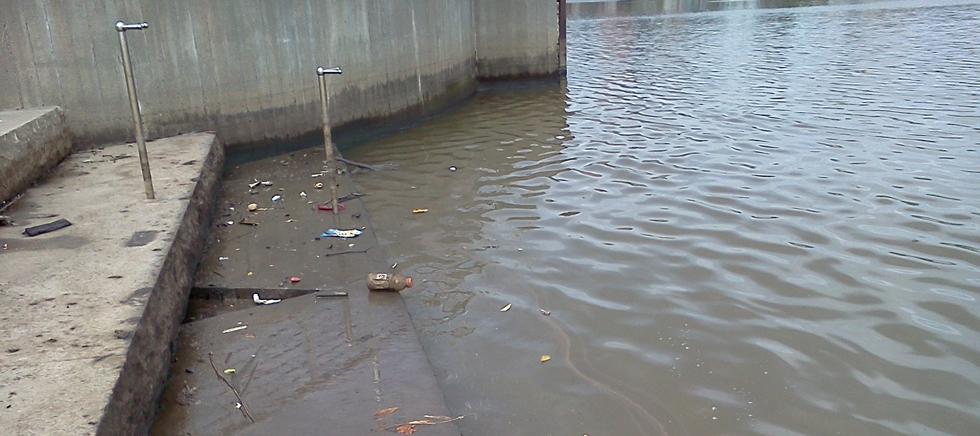From oil to sewage: Monitoring NYC’s Newtown Creek

The Industrial Revolution brought factories, higher population and economic prosperity to New York City. But the heyday of economic growth had an environmental side-effect, which is still felt a century later.
Sawmills, glue factories, coal yards and other industrial sites left behind pollution that still affects waterways in the city. Newtown Creek is one of them.
Contaminated runoff from the time has left it in a dire state. The U.S. Environmental Protection Agency named it one of the most polluted waterways in the United States. The oil spill didn’t help.
“The creek is the site of one of the largest spills in U.S. history, bigger than the Exxon Valdez,” said Sarah Durand, associate professor of biology at LaGuardia Community College. “But major oil companies are still pumping. Oil is still resting on the water and it’s leaching into the waterway.”
The underground spill occurred on Oct. 5, 1950, sending an estimated 17 to 30 million gallons of oil into the soils and aquifers near Newtown Creek. But the extent was unknown until 1978, when the U.S. Coast Guard spotted an oil plume streaming down the creek.
Stormwater monitoring
The damaging effects of the spill are well known now, but Durand recently led a monitoring effort with another focus: stormwater runoff. Durand and her students set out in summer 2012 to study Dutch Kills, one of five tributaries connected to Newtown Creek. They monitored water quality near a combined sewer overflow outfall.
“It occurs because stormwater drains are combined with ones for sewage,” said Durand. “We have an antiquated system that’s poorly designed. It doesn’t account for climate change or the number of people.”
The combined system means non-point source runoff mixes with sewage and empties through bulkheads into Newtown Creek when storm events put too much water in the pipes.
“Everything goes in. Whatever’s on the street – herbicides on lawns, pesticides for rats, vehicle oil, antifreeze, gas,” said Durand. “All the old pharmaceuticals go in. There are restaurants that throw out used cooking oil.”

So Durand’s group went in where everything else was coming out: Dutch Kills Terminal One, monitoring near a bulkhead that releases 10 percent combined sewer outflow. Other bulkheads release as much as 50 percent.
A standard bacteria, enterococcus, was used for testing. The team used precipitation data from the National Oceanic and Atmospheric Association to which it compared levels of the bacteria. Durand, colleagues and students went out twice a week, using Hach monitoring probes and nets for plankton tows. They found that levels of the bacteria were directly correlated to rainfall levels, meaning that stormwater runoff was likely the source.
The group also found that levels of dissolved oxygen tracked closely to rainfall events, which made sense because oxygen levels plummeted as the decomposition process broke down organic matter. At the same time, levels of enterococcus shot up.
Signs of life
Despite low oxygen levels, the plankton tows pulled in some neat finds.
“We were seeing amazing lifeforms. When we found a juvenile horseshoe crab, we were incredulous,” said Durand. “One day we noticed an American eel swimming away from the basin.”
The eel was spotted swimming slowly near the water’s surface, driven out by the low oxygen conditions. Both animals – the horseshoe crab and American eel – should have been near the bottom.
“The ecology in the creek is really disrupted,” said Durand. “But there’s a lot of life in there. External conditions are preventing the diversity normally present.”
Given the long history of neglect and continued contamination, Newtown Creek is in bad shape. Annually, 1.5 billion gallons of raw sewage and polluted stormwater enter the creek. The oil cleanup alone is estimated to last another 20 years and officials from the companies doing the cleanup – BP, ExxonMobil and Chevron/Texaco – expect that only 70 percent of the total can actually be removed.
There are lots of issues to address. The first step, Durand says, is to see what can be achieved if natural habitats are restored.
“Our main mission is remediation using natural habitat,” said Durand. “For example, there’s a ribbed mussel in the creek which is exceptionally good at filtering water, even bacterial cells. The extent of algae blooms diminish as the mussel population increases.”
One small step could be to develop marsh grasses in the area. The ribbed mussels and marsh grasses – spartina is native in Newtown Creek – could mutually benefit one another. The grass roots provide the mussels a place to grow, while the mussels provide nutrients to the grasses through their natural waste.
Durand says that reducing the CSO outflow in conjunction with bringing back natural habitats would make a difference.
“The water is alive and it contains life that can find a foothold. The landscape is just not available,” said Durand. “But there’s a potential in this water for a comeback.”





0 comments